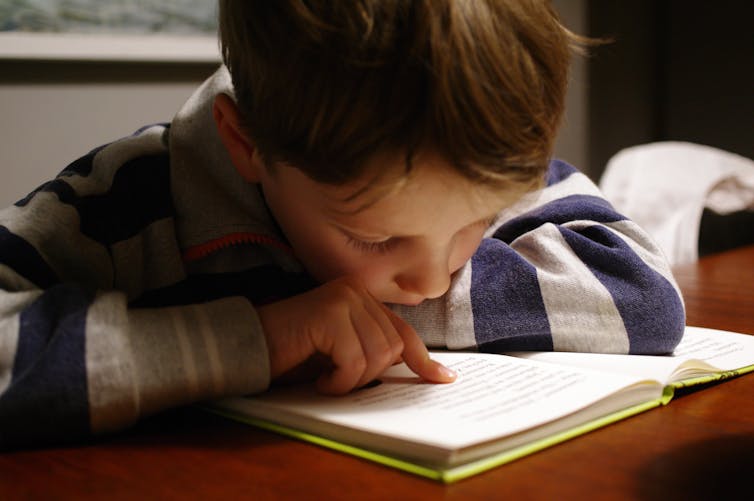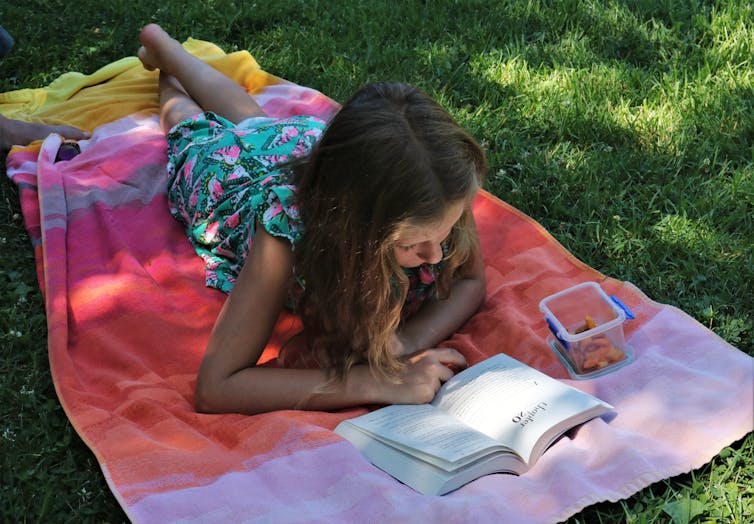Source: The Conversation (Au and NZ) – By Genevieve McArthur, Professor at the Australian Centre for the Advancement of Literacy, Australian Catholic University

Element5 Digital/Pexels , CC BY-SA
Australian children are facing some big challenges. NAPLAN data shows about one in three students in years 3 to 9 are behind in reading-related skills. It is also estimated about one in seven children have poor mental health.
Until recently, most people assumed these were separate problems. However, there is growing evidence difficulties with reading and mental health may be related in some children.
What is reading anxiety?
Recent studies suggest reading anxiety may be the mental health problem most closely related to reading difficulty.
Reading anxiety is an excessive fear of reading that interferes with everyday life. For example, a child may be so anxious about reading they refuse to go school.
Like maths anxiety, reading anxiety can affect both children and adults. In one of our very recent studies (not yet published), we discovered 50% of children with reading difficulties appeared to have reading anxiety. That equates to around one in ten children at primary school.
Read more:
‘Maths anxiety’ is a real thing. Here are 3 ways to help your child cope
How does reading anxiety happen?
Why might a child who struggles with reading also develop reading anxiety? Current evidence suggests the following hypothesis:
When a child first starts school, many children in their class will not read well. However, after a few months of reading lessons, most will start to improve. A few will not. Many of those children will get negative feedback about their reading from others (such as their teachers, parents and other students) or even from themselves.
They will then start to believe they are poor readers. Researchers call this a “poor reading self-concept”.
If a child believes they are bad at reading, they may start to feel worried or scared about reading, particularly in front of other people.
This anxiety can make it hard for them to concentrate in reading classes. Or they find a way to avoid going to reading classes at all, such as playing up in class so they get kicked out of the room.

Michal Parzuchowski/Unsplash, CC BY
A negative cycle
It is important to note these avoidance behaviours are an entirely reasonable response to reading anxiety.
Anxiety is a fight or flight response that evolved to keep humans alive. If you are facing a lion who wants to eat you (or you need to read in front of the class), the last thing you need to do is concentrate hard on learning how the lion’s growl sounds correspond to his paw movements (or how different letters correspond to different speech sounds).
What you really need to do is run away.
The trouble is, when it comes to reading, running away means not attending, or concentrating in, reading classes. This will make everything worse: your reading, your reading self-concept and your reading anxiety. This sets up a cycle of failure that gets stronger over time.
Is it possible to break this cycle?
A couple of recent studies suggest we can help reading anxiety.
In 2021, a case intervention study gave eight Australian primary-school children 12 weeks of very intensive and targeted reading and anxiety intervention. All children showed significant improvements in their targeted reading and anxiety symptoms.
A 2020 Australian study delivered reading self-concept training to 40 children with reading difficulties. As a group, these children showed significant reductions in their non-productive coping strategies (such as procrastination or avoidance).
These results suggest it is possible to improve the mental health of children with reading difficulties with intensive and targeted training. But many more studies are needed before we can be sure.

Skylar Zilka/Unsplash, CC BY
What can parents do?
What can parents do if they suspect their child has problems with reading anxiety?
First, it is important to know both the reading and mental health problems need to be treated by experts. It is not something parents can do alone at home.
However, a parent can help identify if a child needs help. As a starting point, they could ask their child’s teacher, or a reading clinician, to screen their child for problems with reading and reading anxiety. A good free screen for reading is the CC2 word reading test. A good free screen for reading anxiety is the Reading Anxiety Test or RAT.
If the results suggest a child has problems with both reading and reading anxiety, then teachers and reading clinicians can help parents find people to help. Not many people are experts in both reading and anxiety. But good clinicians will happily work together to support the diverse needs of children.
![]()
Genevieve McArthur has received funding from various funding bodies including the Australian Research Council and the National Health and Medical Research Council. She works for the not-for-profit Dyslexia SPELD Foundation as well as the Australian Catholic University.
– ref. Some kids with reading difficulties can also have reading anxiety – what can parents do? – https://theconversation.com/some-kids-with-reading-difficulties-can-also-have-reading-anxiety-what-can-parents-do-215438






